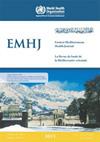Cigarette smoking trajectories among adolescents and young adults in the Islamic Republic of Iran
IF 1.9
4区 医学
Q3 HEALTH CARE SCIENCES & SERVICES
引用次数: 0
Abstract
Background: Cigarette smoking follows a progressive pattern throughout the lifetime; most adult smokers started smoking during adolescence. Aim: To understand the cigarette smoking trajectories and their predictors among adolescents and young adults in the Islamic Republic of Iran. Methods: Using data from the Tehran Lipid and Glucose Study, we followed 1169 adolescents (12–18 years old) into their young adulthood (28–32 years old), from 2002 to 2016. We used cigarette smoking as the outcome variable for group-based trajectory modelling. After detecting the trajectories, we investigated the effects of independent variables, namely, individual employment; education; physical activity; and paternal smoking, employment and education, on the trajectories. We analysed the data using STATA version 16 and SPSS version 26. Results: Three trajectories were detected: non-smokers (79%), experimenters (12%) and escalators (9%). Boys were approximately 3 times (OR = 2.94, 95% CI: 2.32–3.24, P < 0.001) and 25 times (OR = 25.00, 95% CI: 23.92–26.08, P < 0.001), respectively, more likely than girls to be in the experimenter and escalator groups. Receiving a university education decreased the odds of being in the escalator trajectory for 18% (OR = 0.82, 95% CI: -0.04–0.96, P = 0.002) of the study participants. Employment after high school increased the odds by approximately two folds for the experimenter (OR = 2.00, 95% CI: 1.42–2.50, P = 0.01) and escalator (OR = 2.33, 95% CI: 1.33–2.93, P = 0.03) trajectories. Paternal smoking was associated with 1.88 and 2.23, respectively, increased odds of experimenting and escalating smoking among the adolescents. Conclusion: Iranian adolescents follow 3 cigarette smoking trajectories into young adulthood: non-smokers, experimenters and escalators. Male sex, employment after high school, and living with a smoker father were associated with unfavourable smoking patterns. Findings from this study provide valuable insights for designing targeted interventions to reduce cigarette smoking among adults and adolescents in the Islamic Republic of Iran.伊朗伊斯兰共和国青少年的吸烟轨迹
背景:吸烟在人的一生中是一个渐进的过程,大多数成年吸烟者从青少年时期就开始吸烟。目的:了解伊朗伊斯兰共和国青少年的吸烟轨迹及其预测因素。方法:使用德黑兰血脂调查的数据:利用德黑兰血脂和血糖研究(Tehran Lipid and Glucose Study)的数据,我们从 2002 年到 2016 年对 1169 名青少年(12-18 岁)到他们的青年期(28-32 岁)进行了跟踪调查。我们将吸烟作为基于群体的轨迹建模的结果变量。在检测出轨迹后,我们研究了自变量,即个人就业、教育、体育锻炼以及父亲吸烟、就业和教育对轨迹的影响。我们使用 STATA 16 版和 SPSS 26 版对数据进行了分析。结果显示发现了三种轨迹:非吸烟者(79%)、实验者(12%)和升级者(9%)。男生成为实验者和升级者的几率分别是女生的约 3 倍(OR = 2.94,95% CI:2.32-3.24,P < 0.001)和 25 倍(OR = 25.00,95% CI:23.92-26.08,P < 0.001)。接受大学教育降低了 18% 的研究参与者跻身升级轨迹的几率(OR = 0.82,95% CI:-0.04-0.96,P = 0.002)。高中毕业后就业会使实验者轨迹(OR = 2.00,95% CI:1.42-2.50,P = 0.01)和升级者轨迹(OR = 2.33,95% CI:1.33-2.93,P = 0.03)的几率增加约两倍。父亲吸烟与青少年尝试吸烟和吸烟升级的几率分别增加1.88和2.23有关。结论伊朗青少年在成年后有三种吸烟轨迹:不吸烟者、尝试吸烟者和升级吸烟者。男性性别、高中毕业后就业以及与吸烟的父亲生活在一起与不利的吸烟模式有关。这项研究的结果为设计有针对性的干预措施以减少伊朗伊斯兰共和国成人和青少年吸烟提供了宝贵的见解。
本文章由计算机程序翻译,如有差异,请以英文原文为准。
求助全文
约1分钟内获得全文
求助全文
来源期刊

Eastern Mediterranean Health Journal
HEALTH CARE SCIENCES & SERVICESPUBLIC, ENV-PUBLIC, ENVIRONMENTAL & OCCUPATIONAL HEALTH
CiteScore
3.30
自引率
4.80%
发文量
112
期刊介绍:
The Eastern Mediterranean Health Journal, established in 1995, is the flagship health periodical of the World Health Organization Regional Office for the Eastern Mediterranean.
The mission of the Journal is to contribute to improving health in the Eastern Mediterranean Region by publishing and publicising quality health research and information with emphasis on public health and the strategic health priorities of the Region. It aims to: further public health knowledge, policy, practice and education; support health policy-makers, researchers and practitioners; and enable health professionals to remain informed of developments in public health.
The EMHJ:
-publishes original peer-reviewed research and reviews in all areas of public health of relevance to the Eastern Mediterranean Region
-encourages, in particular, research related to the regional health priorities, namely: health systems strengthening; emergency preparedness and response; communicable diseases; noncommunicable diseases and mental health; reproductive, maternal, child health and nutrition
-provides up-to-date information on public health developments with special reference to the Region.
The Journal addresses all members of the health profession, health educational institutes, as well as governmental and nongovernmental organizations in the area of public health within and outside the Region.
 求助内容:
求助内容: 应助结果提醒方式:
应助结果提醒方式:


